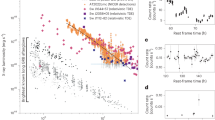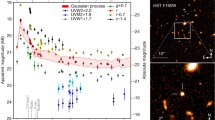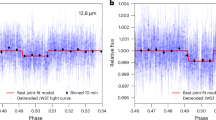Abstract
AN outstanding feature of the May 13, 1971, occultation of Beta Scorpii AB and C by Jupiter was the occurrence of numerous light flashes, or “spikes”. In a discussion of our observations1 we noted that at a time resolution δt∼1 s, the pattern of some of the spikes observed during the emersion of β Sco AB seemed vaguely time-symmetric with that seen during immersion. But other portions of the occultation curves seemed to be largely uncorrelated at this δt. Fairall2 has since published the results of photographic observations of the bright star event. He suggests that the spikes are on the whole significantly time-symmetric, and infers from this a global stratification of the Jovian atmosphere. We have tested this suggestion on our data, which are more extensive and have an improved δt and photometric accuracy.
This is a preview of subscription content, access via your institution
Access options
Subscribe to this journal
Receive 51 print issues and online access
$199.00 per year
only $3.90 per issue
Buy this article
- Purchase on SpringerLink
- Instant access to full article PDF
Prices may be subject to local taxes which are calculated during checkout
Similar content being viewed by others
References
Veverka, J., Elliot, J. L., Liller, W., Sagan, C., and Wasserman, L., Bull. Amer. Astron. Soc., 3, 374 (1971).
Fairall, A. P., Nature, 236, 342 (1972).
Crow, E. L., Davis, F. A., and Maxfield, M. W., Statistics Manual (Dover, New York, 1960).
Freeman, K. C., and Lynga, G., Astrophys. J., 160, 767 (1970).
Brinkmann, R. T., Nature, 230, 515 (1971).
Author information
Authors and Affiliations
Rights and permissions
About this article
Cite this article
VEVERKA, J., ELLIOT, J., SAGAN, C. et al. Jupiter Occultation of Beta Scorpii: Are the Flashes Time-symmetric?. Nature 240, 344–345 (1972). https://doi.org/10.1038/240344a0
Received:
Issue date:
DOI: https://doi.org/10.1038/240344a0



